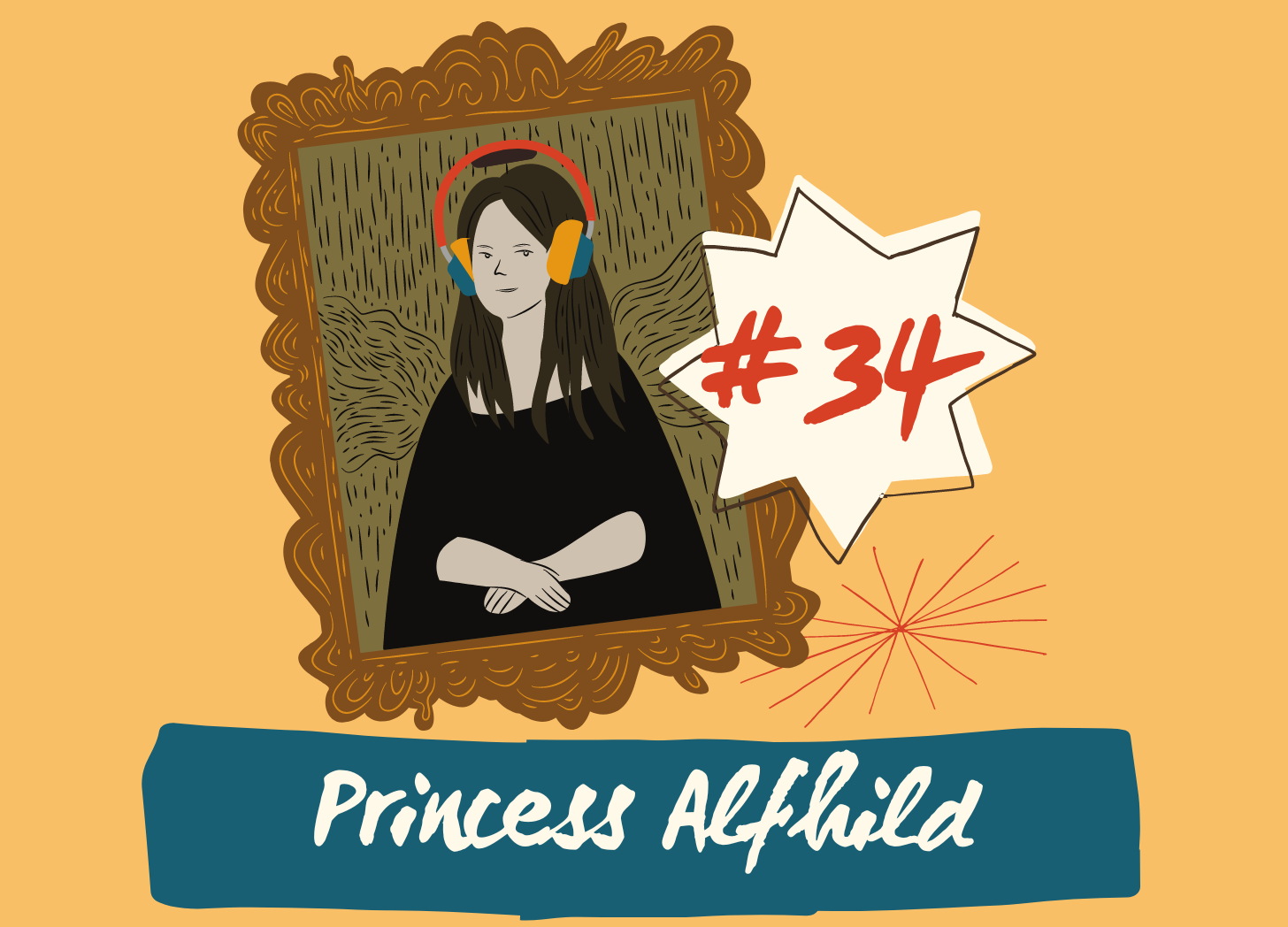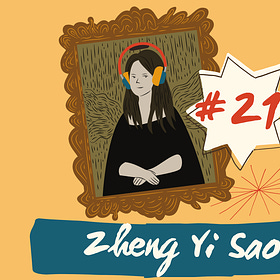Hey everyone,
We’ve got a short but fun one today. This princess decided to become a pirate when her mother discouraged her from marrying the man who had fought some fearsome beasts for the right to do so. It’s an exciting story that—honestly—deserves a movie treatment. Hello, Hollywood? 👀 Enjoy!
🎙️ Transcript
Hey everyone, welcome to Unruly Figures, the podcast that celebrates history’s greatest rule-breakers. I’m your host, Valorie Clark, and today I’m going to be covering Princess Alfhild, a princess who ran away from her arranged marriage to become a pirate.
But before we jump into Alfhild’s life and how she became a notorious Scandinavian pirate in the 6th century, I want to give a huge thank you to all the paying subscribers on Substack who make this podcast possible. Y’all are the best and this podcast wouldn’t still be going without you! Each of these episodes takes me nearly 30 hours of work, which means they’ve become a full-time job. So if you like this show and want more of it, please become a paying subscriber for just $6/month or $60/year! Contributions help ensure that I will be able to continue doing this work. Becoming a paying subscriber will also give you access to exclusive content, merch, and behind-the-scenes updates on the upcoming Unruly Figures book. When you’re ready to do that, head over to unrulyfigures.substack.com.
Also, if you’re listening to this the day it comes out, then happy Mean Girls Day! And if not, well, happy whatever day it is for you. Now, let’s hop in.
As I mentioned, today I’m convering Princess Alfhild, who was maybe not a mean girl, but definitely ran with a clique of girls who people probably were equally awed by and afraid of. So, actually, yeah, maybe she is a mean girl. She’s also a woman whose story is mired in legend and the facts are largely lost to the fog of time.
The story begins in modern-day southeast Sweden, on an island inhabited by a Germanic tribe called the Geats, sometimes called the Goths. If you’ve heard of the Geats before, it’s because Beowulf was the legendary leader of the Geats who fought the monster Grendel and still survives in high-school English reading lists.1 You may already be wondering: Are we talking about Vikings? And the answer is yes—Viking is not an ethnicity but a, well, career more or less. The term can refer to any Scandinavian seafarers, whether they were pirates or traders.
The time period is unclear—some people suggest as late as the tenth century, though most guess around the 5th century CE because of who wrote the story and the idea that warfare among Geatish tribes in Sweden was particularly violent until about the mid-5th or 6th century. We also know that around 530 CE, England stopped importing items from Sweden and immigration from Scandinavia slowed down, which is evidence of declining power and/or declining populations in Sweden around this time.2
If you’re curious about this time period in European history, it’s called the Migration Period, though some people also call it the Dark Ages or the Early Middle Ages. It was marked by widespread migration and warfare—the quote-unquote “fall of Rome” happened around this time too. And Sweden, like almost everywhere in Western Europe, was feeling the impact of all that conflict.
So this story seemingly occurs before things calmed down for the Geats tribe. It begins with a Geatish king named Siward who had two sons, Wemund and Osten, and a daughter named Alfhild, or often Awilda. We don’t know much about Alfhild’s childhood, because we really don’t know much about this time period. It sounds like she lived a relatively comfortable life; she comes down in history to us marked as a princess, so it sounds like she wasn’t impoverished or starving.
A lot of what we know comes from Swedish writer and clergyman Olaus Magnus, who was writing 1,000 years later in the 1500s. By his record, Alfhild was incredibly beautiful but also very modest and chaste. She apparently wore a veil at all times so as to not let her beauty become a temptation to other men, which is how we know this account was written by a clergyman. The logic that she hid her beauty to avoid tempting other men into sin is a big Christian idea—not that it’s only a Christian idea, but it’s definitely a newer idea that rose with the Abrahamic religions. Alfhild may have worn a veil at all times, but the Christianization of Sweden didn’t happen until the 12th century, so I have my doubts about the modesty reason that Magnus gives.
Nevertheless, as she became a teenager--well, I'm guessing here; we don’t have a good age for her, but judging by how the rest of this story goes, I’m going to guess 15 at minimum. So, when she’s getting to a marriable age, her father Siward decided to guard the doors to her bedroom with a viper and a snake which would scare away unworthy suitors. For the record, yes, a viper is a type of snake, I’m not sure why Olaus Magnus has separated them out, though it sounds from his account like one was venomous and one was a constrictor.3 Some people translate this as a lizard and a snake, but artwork from the same time as his account shows two snakes.
So, Alfhild was basically shut up with these creatures—really big princess-in-a-tower energy, right? Siward’s idea was that a suitor who could kill the creatures could marry Alfhild, but any suitor who did not manage to kill the creatures would be “presently” beheaded.4 According to Saxo Grammaticus, writing about this in the twelfth century, the suitor’s head would be displayed on a stake.5 With this possible outcome, it would encourage only the strongest and bravest people to make an attempt.
Of course, someone was up for the challenge. His name was Alf, and he was the son of the King of Denmark. He “covered his body with a raw and bloody hide,”6 apparently to, quote, “make them more frantic against him.”7 According to Magnus, Alf killed the viper first with a pair of red-hot iron pincers. Then, the snake tried to twist around him—which makes me think it was a constrictor—but Alf “slew” it with a spear.8

Siward was pleased with this and agreed that if Alfhild consented, she and Alf could be betrothed. A lot of people paint this as a revolutionary concept for the time, but it really wasn’t. It was common in Norse culture to make sure both parties consented, and women had the right to refuse a suitor without any repercussions.9 So, Alfhild and Alf met and she was apparently charmed by him. According to Magnus, she thought he was handsome and she was ready to marry him.
But for some reason, her mother was annoyed by this. She scolded Alfhild as being too influenced by his “comeliness” and “taken by the allurement of beauty.”10 The only explanation we get for her mother’s interference is some concern that Alfhild apparently hadn’t considered whether or not Alf was a virtuous man. Alfhild, being probably a teenager and possibly a little hot-headed, took her mother’s scolding personally and decided to prove that she was not so easily influenced. Magnus said that she, quote, “she changed her feminine mind and garment into a masculine” and ran away from her family and her betrothed.11
Alfhild fled with at least a couple of other young women—and it’s unclear where these women appeared from. Were they her maids? Were they other girls in the kingdom who didn’t want to get married? Or maybe who wanted to see the world beyond their kingdom? It’s hard to say, and in fact, no one does.
According to Saxo Grammaticus, the Danish historian, this band of women “happened”—that’s the word he used—
“happened to come to a spot where a band of rovers were lamenting the death of their captain, who had been lost in war; they made her their rover-captain for her beauty, and she did deeds beyond the valour of woman.”12
Now, by ‘deeds beyond the valour of woman,’ what Grammaticus means is: Piracy.
She became a Viking! She wouldn’t have called herself a Viking—the earliest recorded use of the word is in 1795—but she was one!13

By some accounts, Alfhild had already begun her piracy career by the time she happened upon the men that Grammaticus mentions. This seems more likely to me—the Geats were a sea-faring people, and she lived on an island, so it makes sense to me that she had access to a ship and at least some knowledge of how to sail one. There’s also only so far a girl can run on an island, so of course she took to the sea as part of her running away plan. It also helps uphold the idea that she had an all-female crew at least for a little while.
However, this still doesn’t explain how Alfhild and her crew operated a Viking longboat, which could be 100 feet long and required a crew of 25 at minimum. They may have taken a knarr, a much smaller ship that required only 6 people to operate because it was primarily for local trading.14 Assuming that Alfhild was fleeing quickly, which is what I’ve been imagining from these records, a knarr makes more sense to me, at least during her initial escape, than a full longboat. Maybe she traded up as she began to see some success raiding.
Unfortunately, we don’t know much about what Alfhild and her crew got up to once they got on the water. We can guess that they were probably like other raiders at the time. They pillaged and murdered, seeking goods and food and land. That said, there’s not even much we can infer from other tales because the Scandinavian people tended to pass on their histories orally. Tales about Vikings were written down either long after the fact, making the truth of them hard to judge, or by the people who survived their raids, who would have been predisposed to present them as bloodthirsty and violent.
But evidence suggests that Vikings often integrated into new societies quite easily; in Pirate Women, Laura Sook Duncombe calls them “business-like, necessity-driven people [who] were a far cry from the bloodstained, vicious men of legend.”15 Many Vikings left home by necessity; Alfhild may just be one in a long line of such travelers.
Alfhild and her crew were successful for quite some time. They were feared along the Baltic and North Sea coasts.16 As her fleet grew, they apparently, quote, “became such a nuisance that several Danish expeditions were launched to stop her, but none returned.”17 One of these Danish expeditions was, of course, captained by the handsome Prince Alf.
Alf, it turns out, had been tracking Alfhild all this time. Some accounts make it seem like he just felt that he had been betrothed and he felt like it was his duty to track her down. Others make it seem like he had fallen in love with Alfhild and was driven to find her for that reason. But Grammaticus makes it seem like Alf didn’t know who he was tracking—instead it sounds like he was trying to get revenge by following someone who had raided his lands. But whatever his motivation, he finally tracked her down. By then, her fleet had grown much larger than his, but he didn’t let that intimidate him.18

According to Grammaticus, Alf’s ship caught up to Alfhild’s in a narrow passage of the Gulf of Finland. Alf leaped off his ship and boarded Alfhild’s, quote, “slaughtering all that withstood him.”19 His comrade Borgar accidentally knocked Alfhild’s helmet off, revealing her true identity, and Alf, quote, “rejoiced that the woman whom he had sought over land and sea in the face of so many dangers was now beyond all expectation in his power.”20
In a passage that Grammaticus seems to think is romantic but I find violent and sad, Alf, quote, “took hold of her eagerly, and made her change her man's apparel for a woman's; and afterwards begot on her a daughter, Gurid.”21 It sounds like she was forced to honor that original betrothal after all, and I do mean forced. They went back to Denmark where Alfhild became queen and, according to Grammaticus, lived happily ever after. However, Alf and his brother Alger went back to their pirating ways before long, which must have stung Alfhild.22
There are slightly different versions of this ending, however. In The Pirates Own Book, by Charles Ellms, Alfhild is impressed that Alf has managed to track her down. Whatever attraction she had initially felt for him, back before her mom talked her out of the marriage, came back and they happily got married. Ellms writes, quote, “his valor had now recommended him to the fair princess, for he persuaded her to accept his hand, married her on board, and then led her to partake of his wealth, and share his throne.”23
Olaus Magnus gives us the old bait-and-switch. He didn’t initially include Alf ever catching up with Alfhild—instead, she became a fierce pirate and never looked back. Quote,
“She so preferred virtue before idleness, that when she might enjoy Kingly dainties she presently applied herself to the wars, drawn on by her feminine fury. And she began to be so averse to all men by a resolute purpose of Chastity, that she firmly resolved with herself never to marry any man; but ever after as a pirate to equal, if not exceed, men’s valor.”24
After that, he does a few chapters on birds and dragons and military stratagems, then just before the close of his book he brings us back to have Alf catch up with Alfhild and “dressed her in the most gallant woman’s habit” before marrying her with all the “commendable ceremonies of the ancients.”25
It seems that Alfhild was able to get away for a few years, but ultimately married the man her father had approved for her. I like that she had adventures with her girl gang first though.
Now, here is the important question: Did Alfhild really exist? Most people think probably not, though a lot of the other people that show up in her story were real. In looking into this, my first thought was that the names Alf and Alfhild are really close—and so I wondered if maybe this was following the pattern set by Zheng Yi Sao, maybe Alfhild just means ‘wife of Alf.’ But it doesn’t! Hild apparently means ‘battle’ in Old Norse, and Alf means ‘elf.’ Though I’m not sure that this really proves Alfhild existed—it’s almost too perfect that the young girl unready to get married is first named ‘elven fighter’ and then decides to become a Viking warrior to avoid that marriage, unless you’re a big believer in nominative determinism, I guess.
Still, I hate to put a damper on a cool story. Alfhild herself may have really existed, but her adventure may not have. There are several tales of women kind of going wild in Norse folklore from around this time, and I believe all of them end with the women happily married back at home, so it may just be a morality tale designed to teach a lesson about how women of the time were supposed to behave.
But, I don’t know, I think it’s possible.
This all-female crew would have been somewhat in the tradition of shield-maidens. The phrasing sounds exotic, but it just refers to a female warrior in Scandinavian mythology and folklore. The evidence for shield-maidens has long been seen as controversial—just google “shield-maiden” and you’ll get results from people claiming these women were all mythical—or, worse, just male fantasy. But there is a growing body of evidence that these women really existed, including the relatively recent revelation that archaeology’s “ideal” Viking warrior grave was actually a woman’s—and that she was a tactician, planning these battles!26
In 2019, an examination and subsequent facial reconstruction of another fallen Viking warrior revealed that it was a woman—and that she had survived a very serious head wound from a sword before ultimately dying of some other cause.27 While several excavated graves have revealed women buried with weapons, this seems to be the first one that decisively proves that women engaged in warfare. In her grave, quote, “her head rested on a shield, a bridled horse skeleton lay curled at her feet, and her body was boxed in by a sword, spear, battle-ax and arrows.”28 Other examples that don’t include damaged bones tend to end with detractors saying that the women were buried with the weapons for symbolic reasons, not possibly because she could have actually fought with them.

This argument that women couldn’t have been Viking warriors has always struck me as silly because women fight in militaries today and we have evidence of women fighting in wars across time. Scandinavian women were equal to their husbands in other areas of life as well, so why not this one? The idea that women didn’t fight was propagated by 19th and early 20th-century archaeologists who were mapping their own experiences and prejudices onto the graves and artifacts they were finding. The reality of that history is probably much richer; so why not shield-maidens? Why not Pirate Princess Alfhild?
That is the story of Princes Alfhild! I hope you enjoyed this episode. You can let me know your thoughts on Substack, Twitter, and Instagram, where my username is unrulyfigures. If you have a moment, please give this show a five-star review on Spotify or Apple Podcasts–it really does help other folks discover the podcast.
This podcast is researched, written, and produced by me, Valorie Clark. My research assistant is Niko Angell-Gargiulo. If you are into supporting independent research, please share this with at least one person you know. Heck, start a group chat! Tell them they can subscribe wherever they get their podcasts, but for ad-free episodes and behind-the-scenes content, come over to unrulyfigures.substack.com.
If you’d like to get in touch, send me an email hello@unrulyfigurespodcast.com If you’d like to send us something, you can send it to P.O. Box 27162 Los Angeles CA 90027.
Until next time, stay unruly.
📚 Bibliography
Campbell, Mike. “Meaning, Origin and History of the Name Alfhild.” Behind the Name. Accessed September 5, 2023. https://www.behindthename.com/name/alfhild.
“Definition of VIKING.” Accessed September 5, 2023. https://www.merriam-webster.com/dictionary/Viking.
Dimri, Bipin. “The Legendary Geats: What Happened to Beowulf’s People?” Historic Mysteries (blog), March 10, 2022. https://www.historicmysteries.com/geats/.
Duncombe, Laura Sook. Pirate Women: The Princesses, Prostitutes, and Privateers Who Ruled the Seven Seas. Chicago, IL, USA: Chicago Review Press, 2019.
Ellms, Charles. The Pirates Own Book: Authentic Narratives of the Most Celebrated Sea Robbers. Portland, Maine: Francis Blake, 1856. https://www.loc.gov/item/47035726/.
Farrell, R.T. “Beowulf Swedes and Geats.” Viking Society for Northern Research, University College London, 1972. http://vsnrweb-publications.org.uk/Beowulf%20Swedes%20andGeats.pdf.
Grammaticus, Saxo. The First Nine Books of the Danish History of Saxo Grammaticus. Translated by Oliver Elton and Frederick York Powell. London: D. Nutt, 1894. http://archive.org/details/firstninebookso00saxo.
Greshko, Michael. “Famous Viking Warrior Was a Woman, DNA Reveals.” National Geographic, September 12, 2017. https://www.nationalgeographic.com/history/article/viking-warrior-woman-archaeology-spd.
“Hild.” In Wiktionary, the Free Dictionary, March 18, 2023. https://en.wiktionary.org/w/index.php?title=hild&oldid=72102265.
Jordanes, and Charles Christopher Mierow, Ph.D. The Gothic History of Jordanes, in English Version, with an Introduction and a Commentary. Princeton, New Jersey: Princeton University Press, 1915.
Magnus, Olaus. A Compendious History of the Goths, Svvedes, and Vandals, and Other Northern Nations. Translated by John Streater. Ginsberg. Storbritannia - London: J. Streater, 1658. https://urn.nb.no/URN:NBN:no-nb_digibok_2018120328001.
Porath, Jason. “Alfhild: The Viking Princess Who Became a Pirate.” Rejected Princesses. Accessed September 1, 2023. https://www.rejectedprincesses.com/princesses/alfhild.
———. Rejected Princesses: Tales of History’s Boldest Heroines, Hellions, and Heretics. Illustrated edition. Dey Street Books, 2016.
Santos, Sorayda. “Female Leaders: A Re-Evaluation of Women During the Viking Age.” City University of New York, 2019. https://academicworks.cuny.edu/cgi/viewcontent.cgi?article=1436&context=hc_sas_etds.
Shah, Tia. “Trailblazers — The Age of Girls: Alfhild.” Girl Museum (blog), October 3, 2018. https://www.girlmuseum.org/trailblazers-the-age-of-girls-alfhild/.
Shaw, David W. “Secrets of the Viking Ships.” Scandinavian Review, no. Autumn 2016 (2016).
Specktor, Brandon. “Battle-Scarred Viking Shield-Maiden Gets Facial Reconstruction for First Time.” Live Science, November 8, 2019. https://www.livescience.com/Viking-shield-maiden-facial-reconstruction.html.
Tewksbury, Drew. “Where Do You Pee on a Viking Ship? An Archaeologist Explains.” Netflix Tudum, November 2, 2022. https://www.netflix.com/tudum/articles/vikings-valhalla-boat-ship-history-women-viking.
Pssst! If you liked this episode, you might like the story of Zheng Yi Sao, the pirate queen of China.
Bipin Dimri, “The Legendary Geats: What Happened to Beowulf’s People?,” Historic Mysteries (blog), March 10, 2022, https://www.historicmysteries.com/geats/.
R.T. Farrell, “Beowulf Swedes and Geats” (Viking Society for Northern Research, University College London, 1972), http://vsnrweb-publications.org.uk/Beowulf%20Swedes%20andGeats.pdf.
Olaus Magnus, A Compendious History of the Goths, Svvedes, and Vandals, and Other Northern Nations, trans. John Streater, Ginsberg (Storbritannia - London: J. Streater, 1658), https://urn.nb.no/URN:NBN:no-nb_digibok_2018120328001.
Magnus, book 5, chapter 18
Saxo Grammaticus, The First Nine Books of the Danish History of Saxo Grammaticus, trans. Oliver Elton and Frederick York Powell (London: D. Nutt, 1894), http://archive.org/details/firstninebookso00saxo.
Magnus, book 5, chapter 18
Grammaticus, 275
Magnus, book 5, chapter 18
Sorayda Santos, “Female Leaders: A Re-Evaluation of Women During the Viking Age” (New York, NY, City University of New York, 2019), https://academicworks.cuny.edu/cgi/viewcontent.cgi?article=1436&context=hc_sas_etds.
Magnus, book 5, chapter 18
Magnus, book 5, chapter 18
Grammaticus, 275
“Definition of VIKING,” accessed September 5, 2023, https://www.merriam-webster.com/dictionary/Viking.
David W Shaw, “Secrets of the Viking Ships,” Scandinavian Review, no. Autumn 2016 (2016).
Laura Sook Duncombe, Pirate Women: The Princesses, Prostitutes, and Privateers Who Ruled the Seven Seas (Chicago, IL, USA: Chicago Review Press, 2019).
Tia Shah, “Trailblazers — The Age of Girls: Alfhild,” Girl Museum (blog), October 3, 2018, https://www.girlmuseum.org/trailblazers-the-age-of-girls-alfhild/.
Jason Porath, Rejected Princesses: Tales of History’s Boldest Heroines, Hellions, and Heretics, Illustrated edition (Dey Street Books, 2016).
Porath, 49
Grammaticus, 276
Grammaticus, 276
Grammaticus, 276
Grammaticus, 277
Charles Ellms, The Pirates Own Book: Authentic Narratives of the Most Celebrated Sea Robbers (Portland, Maine: Francis Blake, 1856), https://www.loc.gov/item/47035726/.
Magnus, book 5, chapter 18
Magnus, book 5, chapter 24
Michael Greshko, “Famous Viking Warrior Was a Woman, DNA Reveals,” National Geographic, September 12, 2017, https://www.nationalgeographic.com/history/article/viking-warrior-woman-archaeology-spd.
Brandon Specktor, “Battle-Scarred Viking Shield-Maiden Gets Facial Reconstruction for First Time,” Live Science, November 8, 2019, https://www.livescience.com/Viking-shield-maiden-facial-reconstruction.html.
Specktor















Share this post